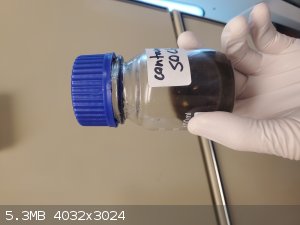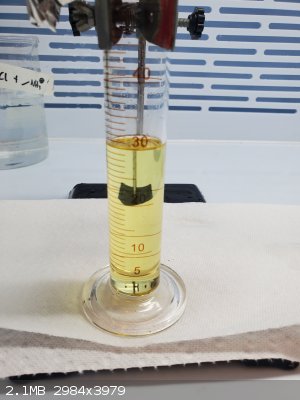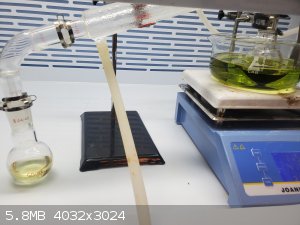| Pages:
1
2 |
Monoamine
Hazard to Others
  
Posts: 168
Registered: 25-5-2021
Location: Sweden(ish)
Member Is Offline
Mood: +7
|
|
Thionly chloride from batteries
Warning: Thionyl chloride produces toxic SO2 gas and HCl gas. User discretion is advised.
I recently saw that it's quite common to find so called "Li-SOCl2" batteries for sale. These batteries consist of a solid lithium anode and
a liquid cathode made of SOCl2. Considering that most chemical suppliers in the west won't sell this nasty reagent to individuals, this
would seem like a found treasure indeed!
Has anyone here tried this before and what was yoir experience?
|
|
|
njl
National Hazard
   
Posts: 609
Registered: 26-11-2019
Location: under the sycamore tree
Member Is Offline
Mood: ambivalent
|
|
I've looked into it a little, they seem very expensive for a frankly tiny amount of SOCl2
Reflux condenser?? I barely know her!
|
|
|
paulll
Hazard to Others
  
Posts: 112
Registered: 1-5-2018
Member Is Offline
Mood: It's fine. Really.
|
|
Quote: Originally posted by njl  | | I've looked into it a little, they seem very expensive for a frankly tiny amount of SOCl2 |
That was my initial impression, I'd hoped there was more to it. Even if one could get a big whack of these things for little outlay I can't see
getting a useful stock of clean thionyl chloride out of it. Still hoping I'm wrong, though!
|
|
|
draculic acid69
International Hazard
    
Posts: 1371
Registered: 2-8-2018
Member Is Offline
|
|
Apparently~48% of the battery weight is thionyl chloride I read somewhere. If true it would be a viable option for small amounts
|
|
|
Oxy
Hazard to Others
  
Posts: 140
Registered: 1-12-2020
Member Is Offline
|
|
I checked SDS of one of the batteries and there is 40-45% SOCl2 by mass, so you're right draculic acid69.
However, the battery costs ~10 Euros and it's mass is 26 grams so it means there is ~10.5 grams of thionyl chloride which is 0.0874 mole.
Kind of expensive source, but maybe if there is a cheaper source of batteries (China?).
|
|
|
BromicAcid
International Hazard
    
Posts: 3272
Registered: 13-7-2003
Location: Wisconsin
Member Is Offline
Mood: Rock n' Roll
|
|
Doesn't seem entirely bad for a sealed, shippable, one-time source of thionyl chloride. Long ago I purchased a 6-pack of sulfur dioxide / lithium
batteries. They were very useful for quick sulfur dioxide experiments.
|
|
|
draculic acid69
International Hazard
    
Posts: 1371
Registered: 2-8-2018
Member Is Offline
|
|
It won't get U a stock supply of the stuff but enough for a small experiment or two. It might not be value for money when compared to buying a liter
but for a small amount with no hassles it's a good enough deal
|
|
|
draculic acid69
International Hazard
    
Posts: 1371
Registered: 2-8-2018
Member Is Offline
|
|
Of course China. It's always China.
|
|
|
draculic acid69
International Hazard
    
Posts: 1371
Registered: 2-8-2018
Member Is Offline
|
|
Strangely enough no one has asked how much lithium is in them.
How much lithium is in them? Anybody?
[Edited on 26-6-2021 by draculic acid69]
|
|
|
karlos³
International Hazard
    
Posts: 1520
Registered: 10-1-2011
Location: yes!
Member Is Offline
Mood: oxazolidinic 8)
|
|
I think in the preparation of the horribly dirty drug thats called "krokodil", they use SOCl2 from batteries for the first step, the chlorination of
codeine to alpha-chlorocodide(from which the name krokodil apparently stems, from mispronounciation).
We know how they proceed further, no need to mention this.
I just mention it because it, well, somehow, illustrates the usefulness of these batteries for OTC thionyl chloride.
If such people can use it reliably(I doubt they distill it, crack the battery open and collect the liquid, thats it at most!), then its likely a good
source for amateurs who actually know how to purify that stuff.
Expensive of course... I would guess that the russian junkies just steal them instead :
|
|
|
Oxy
Hazard to Others
  
Posts: 140
Registered: 1-12-2020
Member Is Offline
|
|
Quote: Originally posted by draculic acid69  | | It won't get U a stock supply of the stuff but enough for a small experiment or two. It might not be value for money when compared to buying a liter
but for a small amount with no hassles it's a good enough deal |
I always forgot that there is no need to buy a large supply all the time, of course you're right.
I checked another battery and it's SDS says that depending on the model there is 18-47 percent of thionyl chloride and 2-6% of lithium metal.
So, before buying it is a good idea to check given model and it's SDS
|
|
|
draculic acid69
International Hazard
    
Posts: 1371
Registered: 2-8-2018
Member Is Offline
|
|
So for a 26 gram battery there will be a gram or so of lithium.
|
|
|
Mush
National Hazard
   
Posts: 634
Registered: 27-12-2008
Member Is Offline
Mood: No Mood
|
|
Similar topic.
http://www.sciencemadness.org/talk/viewthread.php?tid=154324
"The traditional synthesis of desomorphine starts from α-chlorocodide, which is itself obtained by treating thionyl chloride with codeine." WIKI
In Russia, AFIK the clandestine approach is HI/P reduction, in one step.
I have never tried but I would imagine to extract the SOCl2, DIY Glove Box is needed to work in an oxygen free atmosphere. Mainly because of the
lithium fire hazard.
Journal of Power Sources, 4 (1979) 1 - 9
THE LITHIUM-THIONYL CHLORIDE BATTERY - A REVIEW
Attachment: The_Lithium-Thionyl_Chloride_Battery_A_Review.pdf (492kB)
This file has been downloaded 491 times
Attachment: LITHIUM THIONYL CHLORIDE BATTERY.pdf (964kB)
This file has been downloaded 432 times
[Edited on 27-6-2021 by Mush]
|
|
|
Monoamine
Hazard to Others
  
Posts: 168
Registered: 25-5-2021
Location: Sweden(ish)
Member Is Offline
Mood: +7
|
|
Interesting! And yes, definitely want to be careful with the lithium, although considering that not even sodium metal immediately bursts into flames
in air, I'd imagine that if you quickly drain out the SOCl2 and then fill the pattery with paraffin you should probably be ok... (but wearing a blast
shield and keeping a fire extinguisher nearby would definitely not be unwise).
|
|
|
Monoamine
Hazard to Others
  
Posts: 168
Registered: 25-5-2021
Location: Sweden(ish)
Member Is Offline
Mood: +7
|
|
Also, I came across a chemical vendor in India who sells SOCl2 and seems quite legit. In my experience Indian and Chinese chemical vendors tend to be
less uptight than in some other countries. Always had good experiences with them, so it might be worth a shot...
[Edited on 31-7-2021 by Monoamine]
|
|
|
teodor
International Hazard
    
Posts: 1007
Registered: 28-6-2019
Location: Netherlands
Member Is Offline
|
|
In the old good book "Die chemie in wasserähnlichen losungsmittelen" G. Jander there are examples of decomposition of higher chlorides in liquid SO2
:
PCl5 + SO2 = POCl3 + SOCl2
NbCl5 + SO2 = NbOCl3 + SOCl2
WCl6 + SO2 = WOCl4 + SOCl2
They are actually were used as synthetic routes for corresponding oxychlorides preparation because when you try to use water for the preparation it is
unable to stop its solvolytic action and hydrolises goes usually till you get HCl and corresponding oxide. With SO2 as a solvent you can get
oxychloride and SOCl2 as a byproduct in those cases when you get oxide & HCl with water.
Why I am talking about that?
Well, I think that investing in good lab equipment which will allow you to work with liquid SO2 is better than investing in expensive thionyl chloride
batteries which will allow you to get a minute amount of impure SOCl2 which is almost impossible to safely distil in typical amateur settings. Also
this equipment will allow you to explore much more interesting things than even re-distilled SOCl2 .
|
|
|
karlos³
International Hazard
    
Posts: 1520
Registered: 10-1-2011
Location: yes!
Member Is Offline
Mood: oxazolidinic 8)
|
|
Both actually, not to drive this topic off, and I don't know how they do that in practice, but I know from the limited forensic stuff thats out that
its actually the chlorocodide produced first from the codeine pills(usually without extraction), and then they do a HI/P reduction, which
dehalogenates and simulatenously demethylates the still remaining ether.
I actually wonder more about how that would be done, the cracking open of the batteries, and how the further use would be done?
I assume, their technique is neccessarily streamlined, but likely only told by oral history...
I don't if that phenomenom even persists to this day, I believe not.
But their technique for opening the batteries(a junky doesn't care they're overpriced, he steals them) would be pretty interesting for sure.
For those who would attempt this task, at least.
|
|
|
Panache
International Hazard
    
Posts: 1290
Registered: 18-10-2007
Member Is Offline
Mood: Instead of being my deliverance, she had a resemblance to a Kat named Frankenstein
|
|
Theres bound to be a youtube vid of someone doing the entire synth in a walmart aisle soon....
|
|
|
Monoamine
Hazard to Others
  
Posts: 168
Registered: 25-5-2021
Location: Sweden(ish)
Member Is Offline
Mood: +7
|
|
Extraction and crude purification notes and procedure
Ok, so I finally got around to cracking some of these batteries open to try to get some SOCl2 out. Here's a quick summary of the results:
1) The battery was fastened to a labstand inside of the fume hood. Two holes (about 1.3 mm thick) were drilled into the top of the battery (thinner
holes caused liquid to spew out...). (A word of caution here. This suff is really super corrosive. Every time a drop landed
on my nitrile glove it would actually seep through, which was pretty uncomfortable to say the least..)
2) The content was then drained into a cylinder. This was repeated for a total of six batteries. The colour of the liquid was a dark purple-black and
was 40ml in total. So it definitely needs to be purified.

3) The empty batteries were submerged in mineral oil to keep the lithium in the batteries from reacting with moisture.
4) I tried to open one of the batteries using an iron saw, but this didn't really work since I didn't have anywhere to clamp the battery down. So I
just ended up storing them in mineral oil.
5) One observation is that when the liquid in the batteries bubbled out or touched the sides of the funnel, a yellowish solid formed. This clearly
still had some SOCl2 in it, because washing it with water caused acidic fumes to evolve from it (unfortunately I realized this too late to
also collect it). If anyone knows what this solid may be, then I'd be really curious to know.
6) The impure SOCl2 from step 2) was purified by simple distillation (the boiling point of SOCl2 is about 74.6oC).
I'm aware that there are more sophisticated methods for purifying this compound, but unfortunately they are not available to me.
Nonetheless, a translucent faintly yellow liquid was collected, while all the black stuff remained behind).
7) The total amount collected was exactly 30ml, corresponding to an average of 6ml/batter. The somewhat darker yellow than usual also indicates that
the product isn't 100% (but to be honest, I don't think I've ever actually seen commercial SOCl2), but I would guess that it's still mostly
SOCl2 since it fumed like crazy whenever it was poured into a new vessel.

Discussion
So first of all, is it worth it? I guess it depends on your application. I just want it to make some acyl halides, but if you want it of much larger
experiments it's probably a bit of a hassle.
In terms of the cost, I saw that on a certain Chinese Amazon-like marketplace (which by the way has lots of wonderful and cheap reagents etc... btw),
these batteries are sold for less than 10% of the price you pay on the other Amazon.
Also, if you manage to somehow get the lithium out them, then you have that too.
Also, as for safety equipment, as long as you're working in a well ventilated space and use plenty of gloves and ideally some kind of gas mask, you
should be fine. I actually just rinsed the glassware in the sink and the resulting fumes were no problem.
Question: Since I probably won't be using the empty battery shells for their lithium and I also don't exactly want
to dump unprotected lithium into the battery collection bin, might it be a "decent" idea to throw them into a barrel of water far away (in a safe
area), wait for them to go WOOSH! and then collect the rest to through away properly?.
[Edited on 8-8-2021 by Monoamine]
|
|
|
Monoamine
Hazard to Others
  
Posts: 168
Registered: 25-5-2021
Location: Sweden(ish)
Member Is Offline
Mood: +7
|
|

|
|
|
Prepic
Harmless

Posts: 31
Registered: 23-4-2019
Member Is Offline
|
|
Very impressive Monoamine, love to see a guide on how to extract SOCl2 from batteries. I personally think accessibility to chemicals generally
overweighs economic concerns at least when it comes to small scale experiments.
I think your solution to disposal will work well. In the recycling process, metal casing are also recycled.
|
|
|
Monoamine
Hazard to Others
  
Posts: 168
Registered: 25-5-2021
Location: Sweden(ish)
Member Is Offline
Mood: +7
|
|
Quote: Originally posted by Prepic  | Very impressive Monoamine, love to see a guide on how to extract SOCl2 from batteries. I personally think accessibility to chemicals generally
overweighs economic concerns at least when it comes to small scale experiments.
I think your solution to disposal will work well. In the recycling process, metal casing are also recycled. |
Thanks for the tip regarding disposing of the lithium.
One thing I learned from this is also to use a very hard (possibly diamond tipped drill bit, since standard drill bit take ages to get through and I
actually killed a few of them, probably since the SOCl2 corroded them...)
|
|
|
Tdep
National Hazard
   
Posts: 520
Registered: 31-1-2013
Location: Laser broken since Feb 2020 lol
Member Is Offline
Mood: PhD is done! It isn't good but it's over lol
|
|
This worked so much better than I ever thought it would. Well done mate, very cool stuff. Great working having an idea and then seeing it through to
trying it out!
|
|
|
karlos³
International Hazard
    
Posts: 1520
Registered: 10-1-2011
Location: yes!
Member Is Offline
Mood: oxazolidinic 8)
|
|
Thats really interesting.
Can you give a rough calculation, without your working hours, what all that "fun" has cost you now, just the material itself? 
I am actually quite surprised that these batteries as a source seem to be much more viable than I suspected them to be.
I will stil prefer buying it, but its very good to see someone figuring that out successfully in practice 
|
|
|
teodor
International Hazard
    
Posts: 1007
Registered: 28-6-2019
Location: Netherlands
Member Is Offline
|
|
"Also, as for safety equipment, as long as you're working in a well ventilated space and use plenty of gloves and ideally some kind of gas mask, you
should be fine. I actually just rinsed the glassware in the sink and the resulting fumes were no problem."
You are not quite right, Monoamine, repeating again that the danger is associated with SOCl2 decomposition products, those HCl and SO2 fumes. The
toxicity is connected with SOCl2 itself.
1. It is very volatile. Vapour pressure is 1/2 of acetone. There is not enough water vapour in the air to neutralise it.
2. The fumes are denser than air. Ventilation which can work well with most of other compound (let say, NO2, HCl or SO2) doesn't work well.
3. Usual gas mask with protection from "acid fumes" doesn't protect at the same level.
4. I red studies of SOBr2 toxic action but I think for SOCl2 it should be similar. When somebody breath its fumes he gets SOBr2 dissolved in fat.
So, I am glad you managed the process but I think you don't properly marked the dangers, making accents on decomposition products HCl and SO2. SOCl2
is much more toxic than any of them.
Also I can see you were working in a professional fume hood with baffles. Baffles are effective against dense fumes SOCl2. But I believe this element
could be absent in many DIY fume hoods.
[Edited on 9-8-2021 by teodor]
|
|
|
| Pages:
1
2 |